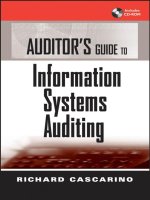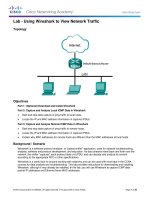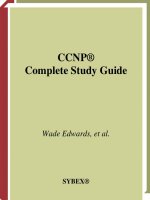Auditors guide to information systems auditing kho tài liệu training
Bạn đang xem bản rút gọn của tài liệu. Xem và tải ngay bản đầy đủ của tài liệu tại đây (4.52 MB, 511 trang )
ch00_FM_4768
1/8/07
2:42 PM
Page iii
Auditor’s
Guide to
Information
Systems
Auditing
RICHARD E. CASCARINO
John Wiley & Sons, Inc.
ch00_FM_4768
1/8/07
2:42 PM
Page ii
ch00_FM_4768
1/8/07
2:42 PM
Page i
Auditor’s
Guide to
Information
Systems
Auditing
ch00_FM_4768
1/8/07
2:42 PM
Page ii
ch00_FM_4768
1/8/07
2:42 PM
Page iii
Auditor’s
Guide to
Information
Systems
Auditing
RICHARD E. CASCARINO
John Wiley & Sons, Inc.
ch00_FM_4768
1/8/07
2:42 PM
Page iv
This book is printed on acid-free paper.
Copyright © 2007 John Wiley & Sons, Inc. All rights reserved.
Wiley Bicentennial Logo: Richard J. Pacifico.
Published by John Wiley & Sons, Inc., Hoboken, New Jersey.
Published simultaneously in Canada.
No part of this publication may be reproduced, stored in a retrieval system, or transmitted in any form or by any means, electronic, mechanical, photocopying, recording, scanning, or otherwise, except as permitted under Section 107 or 108 of the 1976 United States
Copyright Act, without either the prior written permission of the Publisher, or authorization through payment of the appropriate per-copy fee to the Copyright Clearance Center,
Inc., 222 Rosewood Drive, Danvers, MA 01923, 978-750-8400, fax 978-646-8600, or on
the web at www.copyright.com. Requests to the Publisher for permission should be
addressed to the Permissions Department, John Wiley & Sons, Inc., 111 River Street,
Hoboken, NJ 07030, 201-748-6011, fax 201-748-6008, or online at ey
.com/go/permissions.
Limit of Liability/Disclaimer of Warranty: While the publisher and author have used their
best efforts in preparing this book, they make no representations or warranties with
respect to the accuracy or completeness of the contents of this book and specifically disclaim any implied warranties of merchantability or fitness for a particular purpose. No
warranty may be created or extended by sales representatives or written sales materials.
The advice and strategies contained herein may not be suitable for your situation. You
should consult with a professional where appropriate. Neither the publisher nor author
shall be liable for any loss of profit or any other commercial damages, including but not
limited to special, incidental, consequential, or other damages.
For general information on our other products and services, or technical support, please
contact our Customer Care Department within the United States at 800-762-2974, outside the United States at 317-572-3993 or fax 317-572-4002.
Wiley also publishes its books in a variety of electronic formats. Some content that appears
in print may not be available in electronic books.
For more information about Wiley products, visit our Web site at .
Library of Congress Cataloging-in-Publication Data
Cascarino, Richard.
Auditor’s guide to information systems auditing / Richard E. Cascarino.
p. cm.
Includes index.
ISBN: 978-0-470-00989-5 (cloth : alk. paper)
1. Electronic data processing—Auditing. I. Title.
QA76.9.A93C37 2007
658’.0558—dc22
2006033470
Printed in the United States of America
10 9 8 7 6 5 4 3 2 1
ch00_FM_4768
1/8/07
2:42 PM
Page v
Dedication
wish to take this opportunity to dedicate this book to my wife Max
who has, over the last 33 years, put up with my bad temper when
the computer would not do what I programmed it to do; my ego
when it did eventually work; my despair when the system crashed
again and again, and my complacency when the problems were
solved.
I would also like to thank those who molded my career over the
years, particularly Jim Leary for showing me what an IS manager
could be and Scotch Duncan Anderson for showing me what an Internal Auditor should be.
I
v
ch00_FM_4768
1/8/07
2:42 PM
Page vi
ch00_FM_4768
1/8/07
2:42 PM
Page vii
Contents
PREFACE
ABOUT THE CD
PART I
IS Audit Process
CHAPTER 1
Technology and Audit
Technology and Audit
Batch and On-Line Systems
CHAPTER 2
IS Audit Function Knowledge
Information Systems Auditing
What Is Management?
Management Process
Understanding the Organization’s Business
Establishing the Needs
Identifying Key Activities
Establish Performance Objectives
Decide The Control Strategies
Implement and Monitor the Controls
Executive Management’s Responsibility and Corporate Governance
Audit Role
Conceptual Foundation
Professionalism within the IS Auditing Function
Relationship of Internal IS Audit to the External Auditor
Relationship of IS Audit to Other Company Audit Activities
Audit Charter
Charter Content
Outsourcing the IS Audit Activity
Regulation, Control, and Standards
xix
xxxiii
1
3
4
9
24
24
25
25
26
26
26
27
27
27
28
28
29
29
30
30
30
31
31
32
vii
ch00_FM_4768
1/8/07
2:42 PM
Page viii
viii
Contents
CHAPTER 3
IS Risk and Fundamental Auditing Concepts
Computer Risks and Exposures
Effect of Risk
Audit and Risk
Audit Evidence
Reliability of Audit Evidence
Audit Evidence Procedures
Responsibilities for Fraud Detection and Prevention
CHAPTER 4
Standards and Guidelines for IS Auditing
IIA Standards
Code of Ethics
Advisory
Aids
Standards for the Professional Performance of Internal Auditing
ISACA Standards
ISACA Code of Ethics
COSO: Internal Control Standards
BS 7799 and ISO 17799: IT Security
NIST
BSI Baselines
CHAPTER 5
Internal Controls Concepts Knowledge
Internal Controls
Cost/Benefit Considerations
Internal Control Objectives
Types Of Internal Controls
Systems of Internal Control
Elements of Internal Control
Manual and Automated Systems
Control Procedures
Application Controls
Control Objectives and Risks
General Control Objectives
Data and Transactions Objectives
Program Control Objectives
Corporate IT Governance
CHAPTER 6
Risk Management of the IS Function
Nature of Risk
Auditing in General
33
33
35
37
39
39
40
41
43
43
44
46
46
47
47
49
49
51
53
54
57
57
59
59
61
62
63
64
65
65
66
67
67
68
69
75
75
76
ch00_FM_4768
1/8/07
2:42 PM
Page ix
Contents
Elements of Risk Analysis
Defining the Audit Universe
Computer System Threats
Risk Management
CHAPTER 7
Audit Planning Process
Benefits of an Audit Plan
Structure of the Plan
Types of Audit
CHAPTER 8
Audit Management
Planning
Audit Mission
IS Audit Mission
Organization of the Function
Staffing
IS Audit as a Support Function
Planning
Business Information Systems
Integrated IS Auditor vs Integrated IS Audit
Auditees as Part of the Audit Team
Application Audit Tools
Advanced Systems
Specialist Auditor
IS Audit Quality Assurance
CHAPTER 9
Audit Evidence Process
Audit Evidence
Audit Evidence Procedures
Criteria for Success
Statistical Sampling
Why Sample?
Judgmental (or Non-Statistical) Sampling
Statistical Approach
Sampling Risk
Assessing Sampling Risk
Planning a Sampling Application
Calculating Sample Size
Quantitative Methods
Project Scheduling Techniques
Simulations
Computer Assisted Audit Solutions
ix
78
79
81
83
88
88
93
96
98
98
99
99
100
101
103
103
104
104
106
107
107
107
108
109
109
109
110
112
112
113
114
114
116
116
119
122
125
127
128
ch00_FM_4768
1/8/07
2:42 PM
Page x
x
Contents
Generalized Audit Software
Application and Industry-Related Audit Software
Customized Audit Software
Information Retrieval Software
Utilities
On-Line Inquiry
Conventional Programming Languages
Microcomputer-Based Software
Test Transaction Techniques
CHAPTER 10
Audit Reporting Follow-up
Audit Reporting
Interim Reporting
Closing Conferences
Written Reports
Clear Writing Techniques
Preparing To Write
Basic Audit Report
Executive Summary
Detailed Findings
Polishing the Report
Distributing the Report
Follow-Up Reporting
Types of Follow-Up Action
PART II
Information Systems/Information Technology Governance
CHAPTER 11
Management
IS Infrastructures
Project-Based Functions
Quality Control
Operations and Production
Technical Services
Performance Measurement and Reporting
Measurement Implementation
CHAPTER 12
Strategic Planning
Strategic Management Process
Strategic Drivers
New Audit Revolution
129
130
130
131
131
131
131
132
132
134
134
135
135
135
136
138
139
140
140
142
142
143
144
145
147
147
148
154
155
156
156
158
164
164
165
166
ch00_FM_4768
1/8/07
2:42 PM
Page xi
Contents
Leveraging IS
Business Process Re-Engineering Motivation
IS as an Enabler of Re-Engineering
Dangers of Change
System Models
Information Resource Management
Strategic Planning for IS
Decision Support Systems
Steering Committees
Strategic Focus
Auditing Strategic Planning
Design the Audit Procedures
CHAPTER 13
Management Issues
Privacy
Copyrights, Trademarks, and Patents
Ethical Issues
Corporate Codes of Conduct
IT Governance
Sarbanes-Oxley Act
Housekeeping
CHAPTER 14
Support Tools and Frameworks
General Frameworks
COSO: Internal Control Standards
Other Standards
CHAPTER 15
Governance Techniques
Change Control
Problem Management
Auditing Change Control
Operational Reviews
Performance Measurement
ISO 9000 Reviews
xi
166
167
168
168
169
170
171
173
174
174
175
176
177
179
180
181
182
184
186
186
188
188
192
193
196
196
198
199
199
200
201
PART III
Systems and Infrastructure Lifecycle Management
205
CHAPTER 16
Information Systems Planning
207
ch00_FM_4768
1/8/07
2:42 PM
Page xii
xii
Contents
Stakeholders
Operations
Systems Development
Technical Support
Other System Users
Segregation of Duties
Personnel Practices
Object-Oriented Systems Analysis
Enterprise Resource Planning
CHAPTER 17
Information Management and Usage
What Are Advanced Systems?
Service Delivery and Management
CHAPTER 18
Development, Acquisition, and Maintenance of Information Systems
Programming Computers
Program Conversions
System Failures
Systems Development Exposures
Systems Development Controls
Systems Development Life Cycle Control: Control Objectives
Micro-Based Systems
CHAPTER 19
Impact of Information Technology on the Business Processes and Solutions
Impact
Continuous Monitoring
Business Process Outsourcing
E-Business
CHAPTER 20
Software Development
Developing a System
Change Control
Why Do Systems Fail?
Auditor’s Role in Software Development
207
208
209
210
212
212
214
215
216
218
218
221
227
227
229
229
232
233
233
235
236
236
237
238
239
241
241
245
247
249
CHAPTER 21
Audit and Control of Purchased Packages
251
Information Systems Vendors
Request For Information
Requirements Definition
Request For Proposal
252
253
254
255
ch00_FM_4768
1/8/07
2:42 PM
Page xiii
Contents
Installation
Systems Maintenance
Systems Maintenance Review
Outsourcing
CHAPTER 22
Audit Role in Feasibility Studies and Conversions
Feasibility Success Factors
Conversion Success Factors
CHAPTER 23
Audit and Development of Application Controls
What Are Systems?
Classifying Systems
Controlling Systems
Control Stages
System Models
Information Resource Management
Control Objectives of Business Systems
General Control Objectives
CAATS and their Role in Business Systems Auditing
Common Problems
Audit Procedures
CAAT Use in Non-Computerized Areas
Designing an Appropriate Audit Program
PART IV
Information Technology Service Delivery and Support
CHAPTER 24
Technical Infrastructure
Auditing the Technical Infrastructure
Computer Operations Controls
Operations Exposures
Operations Controls
Personnel Controls
Supervisory Controls
Operations Audits
CHAPTER 25
Service Center Management
Continuity Management and Disaster Recovery
Managing Service Center Change
xiii
256
257
257
258
259
259
263
264
264
265
266
266
266
267
268
269
271
274
274
275
275
277
279
282
284
285
286
286
286
287
289
289
293
ch00_FM_4768
1/8/07
2:42 PM
Page xiv
xiv
Contents
PART V
Protection of Information Assets
CHAPTER 26
Information Assets Security Management
What Is Information Systems Security?
Control Techniques
Workstation Security
Physical Security
Logical Security
User Authentication
Communications Security
Encryption
How Encryption Works
Encryption Weaknesses
Potential Encryption
Data Integrity
Double Public Key Encryption
Steganography
Information Security Policy
CHAPTER 27
Logical Information Technology Security
Computer Operating Systems
Tailoring the Operating System
Auditing the Operating System
Security
Criteria
Security Systems: Resource Access Control Facility
Auditing RACF
Access Control Facility 2
Top Secret
User Authentication
Bypass Mechanisms
CHAPTER 28
Applied Information Technology Security
Communications and Network Security
Network Protection
Hardening the Operating Environment
Client Server and Other Environments
Firewalls and Other Protection Resources
Intrusion Detection Systems
295
297
297
300
301
301
301
302
302
302
303
304
305
305
306
307
308
310
310
311
312
313
314
314
315
316
317
318
319
321
321
323
324
325
326
329
ch00_FM_4768
1/8/07
2:42 PM
Page xv
Contents
xv
CHAPTER 29
Physical and Environmental Security
330
Control Mechanisms
Implementing the Controls
332
336
PART VI
Business Continuity and Disaster Recovery
337
CHAPTER 30
Protection of the Information Technology Architecture and Assets: Disaster Recovery
Planning
339
Risk Reassessment
Disaster—Before and After
Consequences of Disruption
Where to Start
Testing the Plan
Auditing the Plan
CHAPTER 31
Insurance
Self-Insurance
PART VII
Advanced IS Auditing
CHAPTER 32
Auditing E-commerce Systems
E-Commerce and Electronic Data Interchange: What Is It?
Opportunities and Threats
Risk Factors
Threat List
Security Technology
“Layer” Concept
Authentication
Encryption
Trading Partner Agreements
Risks and Controls within EDI and E-Commerce
Nonrepudiation
E-Commerce and Auditability
Compliance Auditing
E-Commerce Audit Approach
341
341
343
344
345
346
349
353
355
357
357
358
362
363
363
363
364
364
366
366
367
368
369
370
ch00_FM_4768
1/8/07
2:42 PM
Page xvi
xvi
Contents
Audit Tools and Techniques
Auditing Security Control Structures
Computer Assisted Audit Techniques
CHAPTER 33
Auditing UNIX/Linux
History
Security and Control in a UNIX/Linux System
Architecture
UNIX Security
Services
Daemons
Auditing UNIX
Scrutiny of Logs
Audit Tools in the Public Domain
UNIX passwd File
Auditing UNIX Passwords
CHAPTER 34
Auditing Windows
History
NT and Its Derivatives
Auditing Windows 23
Password Protection
File Sharing
Security Checklist
CHAPTER 35
Foiling the System Hackers
CHAPTER 36
Investigating Information Technology Fraud
Pre-Incident Preparation
Detection of Incidents
Initial Response
Forensic Backups
Investigation
Network Monitoring
Identity Theft
371
372
372
374
374
377
377
378
379
380
380
381
381
382
383
385
385
386
388
389
390
391
393
397
399
401
401
403
404
404
405
ch00_FM_4768
1/8/07
2:42 PM
Page xvii
xvii
Contents
APPENDICES
APPENDIX A Ethics and Standards for the IS Auditor
ISACA Code of Professional Ethics
Relationship of Standards to Guidelines and Procedures
407
407
408
APPENDIX B Audit Program for Application Systems Auditing
410
APPENDIX C Logical Access Control Audit Program
432
APPENDIX D Audit Program for Auditing UNIX/Linux Environments
446
APPENDIX E
454
Index
Audit Program for Auditing Windows XP/2000 Environments
463
ch00_FM_4768
1/8/07
2:42 PM
Page xviii
ch00_FM_4768
1/8/07
2:42 PM
Page xix
Preface
n today’s business environment, computers are continuing the revolution started in the 1950s. Size and capacity of the equipment
grows on an exponential curve, with the reduction in cost and size
ensuring that organizations take advantage of this to develop more
effective and responsive systems, which allow them to seek to gain
competitive advantage by interfacing more closely with their customers.
Net technologies such as electronic data interchange (EDI), electronic funds transfers (EFTs), and E-commerce have fundamentally
changed the nature of business itself and, as a result, organizations
have become more computer dependent. The radical changes to business are matched only by their impact on society.
It has become impossible for today’s enterprises of any size and in
any market sector to exist without computers to assist with their fundamental business operations. Even the old adage that “we can
always go back to manual operations” is today a fallacy. The nature
of today’s business environment obviates that option. Even the smallest businesses have found that the advent of personal computers (PCs)
with increased capabilities and processing speed, while at the same
time reduced pricing and sophisticated PC software, has revolutionized the concept of what a small business is.
In order for organizations to take full advantage of the new facilities that computers can offer, it is important that their systems can be
controlled and are dependable. They require that their auditors confirm that this is the case. The modern auditor therefore requires significantly more knowledge of computers and computer auditing than
did auditors of earlier years.
I
xix
ch00_FM_4768
1/8/07
2:42 PM
Page xx
xx
Preface
CONTROLS IN MODERN COMPUTER SYSTEMS
The introduction of the computer has brought fundamental changes
to the ways organizations process data. Computer systems:
■
■
■
■
■
■
Are frequently much more complex than manual systems, the
larger systems at least requiring a number of highly skilled computer technicians to develop and maintain them.
Process large volumes of data at high speed, and can transmit data
effectively instantaneously over extreme distances, commonly
between continents.
Hold data in electronic form, which, without the appropriate
tools and techniques, is often more complex for the auditor to
access than paper records. In addition, modern systems have
reduced the volumes of printed outputs by the incorporation of
on-line access and on-line inquiry facilities. Indeed, many modern
EDI-type systems have no paper audit trail whatsoever.
Process data with much less manual intervention than manual
systems. In fact large parts of sophisticated systems now process
data with no manual intervention at all. In the past, the main justification for computerization was frequently to reduce the number of staff required to operate the business. With modern
decision support and integrated systems, this is becoming a reality not at the clerical level, but at the decision-making and control level. This can have the effect that the fundamental business
controls previously relied upon by the auditor, such as segregation of duties or management authorization, may no longer be
carried out as previously and must be audited in a different manner. In computer systems, the user profile of the member of staff
as defined within the system’s access rights will generally control
the division of duties while managerial authorities are, in many
cases, built into systems themselves.
Process consistently in accordance with their programs providing
the computer has been programmed correctly and change control
is effective.
In large minicomputer and mainframe systems, there is a significant concentration of risk in locating the organization’s information resource in one format although not necessarily in one place.
Organizations then become totally reliant on their computer sys-
ch00_FM_4768
1/8/07
Preface
■
2:42 PM
Page xxi
xxi
tem and must be able to recover from failure or the destruction
of their computer system swiftly and with minimal business
disruption.
Are often subject to different legal constraints and burdens of
proof than manual systems.
These changes brought about by computerization can greatly
increase the opportunity for auditors to deliver a quality service by
concentrating the risk and allowing the auditors to correspondingly
concentrate their efforts. For example, harnessing the power of the
computer to analyze large volumes of data in the way the auditor
requires is commonly now the only practical way of analyzing corporate data, and this was not only impractical but also impossible
while data was spread around the organization in a myriad of forms.
In addition, the use of computer systems with built-in programmed procedures permit the auditor to adopt a systems approach
to auditing in that the controls within the computer system process in
a more consistent manner than a manual system. In manual systems
the quality of the control procedure can change on a day-by-day
basis, depending on the quality of the staff and their consistency of
working. This can result in the auditor having to undertake a substantial amount of checking of transactions, to confirm transactions
have processed correctly.
Controls within computer systems are commonly classified in two
main subdivisions:
1. General controls. The controls governing the environment in
which the computer system is developed, maintained, and operated, and within which the application controls operate. These
controls include the systems development standards operated by
the organization, the controls that apply to the operation of the
computer installation, and those governing the functioning of
systems software. They have a pervasive effect on all application
systems.
2. Application controls. The controls, both manual and computerized, within the business application to ensure that data is
processed completely, accurately, and in a timely manner. Application controls are typically specific to the business application
and include:
ch00_FM_4768
1/8/07
2:42 PM
Page xxii
xxii
Preface
■
Input controls such as data validation and batching
Run-to-run controls to check file totals at key stages in processing, and controls over output
■
Ultimately, the auditor’s job is to determine if the application systems function as intended, the integrity, accuracy, and completeness
of the data is well controlled, and report any significant discrepancies. The integrity of the data relies on the adequacy of the application controls. However, application controls are totally dependent on
the integrity of the general controls over the environment within
which the application is developed and run.
In the past, the auditor has often assumed a considerable degree
of reliance on controls around the computer, that is, in the application controls. This is sometimes referred to as auditing “around” the
computer, because the auditor concentrates on the input and output
from the computer, rather than what happens in the computer.
This has never been truly justified but has become, over recent
years, a lethal assumption.
With the spread of on-line and real-time working, and of the
increasing capacity of fixed disks, all of the organization’s data is
commonly permanently loaded on the computer system and accessible from a variety of places, with only systems software controls preventing access to the data. This system is increasing in technical
complexity and the ability to utilize any implemented weaknesses is
also growing.
It is critical that the auditor is assured of the integrity of the computer operational environment within which the applications systems
function. This means that the auditor must become knowledgeable in
the facilities provided in key systems software in the organization
being audited.
This book is designed for those who need to gain a practical
working knowledge of the risks and control opportunities within an
IT environment, and the auditing of that environment. Readers who
will find the text particularly useful include professionals and students within the fields of:
■
■
■
IT security
IT audit
Internal audit









